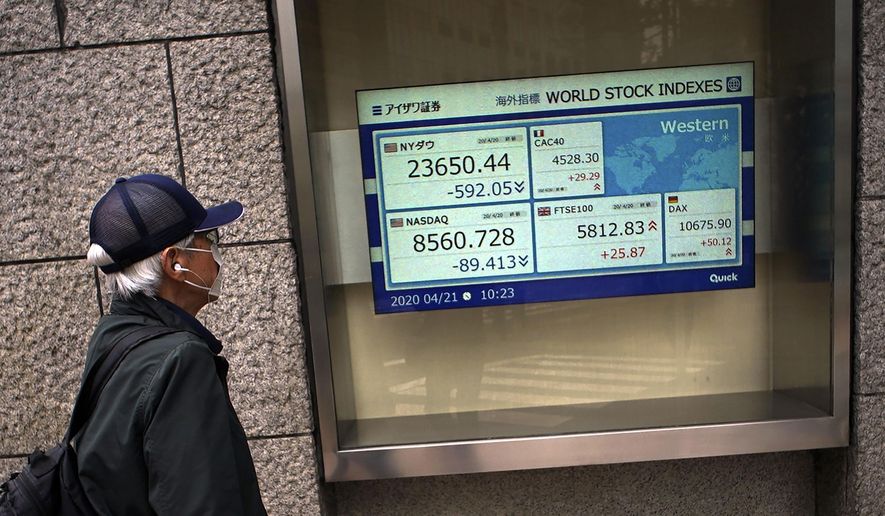NEW YORK (AP) — Oil’s chaotic collapse deepened, and stocks around the world dropped on Tuesday as the economic carnage caused by the coronavirus pandemic turns markets upside down.
A day after oil futures plunged below zero for the first time, traders in one corner of the U.S. crude market were still close to paying others to take it off their hands. That’s a market quirk created by a glut of oil, which has traders running out of places to store it in the near term.
Prices remain well above zero for oil elsewhere in the world and for deliveries further into the future, which analysts consider to be closer to the “true” price of crude. But they also slid sharply Tuesday on the same ultimate concern: A global economy incapacitated by the virus outbreak doesn’t need to burn as much fuel. Airplanes are parked, cars are garaged and factories are idled with millions of workers losing their jobs every week.
The crumbling oil market helped drag stocks to their second straight day of losses, and the S&P 500 was down 3.2%, as of 11:40 a.m. Eastern time, following similar drops across Europe and Asia.
The Dow Jones Industrial Average fell 685 points, or 2.9%, to 22,965, and the Nasdaq was down 3.9% The losses accelerated as the day progressed, and they were widespread. All but a dozen of the 500 companies the S&P 500 were down.
In another sign of the worry washing over markets, Treasury yields fell further. The yield on the 10-year Treasury dropped to 0.54% from 0.62% late Monday, meaning investors are willing to get paid even less to get the safety of owning a U.S. government bond. At the start of the year, before economies worldwide went on lockdown to slow the spread of the virus, investors were getting paid about 1.90% to own a 10-year Treasury.
Even with all the chaos in the oil markets, some signs of economic activity on the horizon were poking through elsewhere. The Senate’s Democratic leader said negotiators reached agreement on major elements of a nearly $500 billion proposal to provide more loans and aid to small businesses and hospitals. Georgia’s governor, meanwhile, announced plans late Monday to allow gyms, hair salons and other businesses to reopen as early as Friday.
Rising optimism among some investors that parts of the economy could reopen as infections level off have helped stocks rally recently, and the S&P 500 is up more than 20% since hitting a low in late March. The rally got its start after the Federal Reserve and Congress promised massive amounts of aid for the economy.
But the data coming in on the economy in the here and now continues to be dismal, including a Tuesday report that showed the steepest drop for U.S. sales of previously occupied homes since 2015. Pessimists say the market’s rally has been overdone and that a premature reopening of the economy could lead to only more flareups of infections.
Companies are also describing the hit to earnings they’re taking due to the outbreak, with many pulling their financial forecasts for the year given all the uncertainty about how long this recession will last. Coca-Cola said Tuesday that its sales were on track to hit financial targets through February, but that all changed when stay-at-home orders became widespread in March. It said it’s hopeful that improvement could arrive in the second half of the year. IBM on late Monday withdrew its guidance for 2020 results and said it will reassess at the end of June.
The economic pain is perhaps most clear in the oil market. A barrel of U.S. oil to be delivered in May was at negative $1.48 just before stocks began trading in New York Tuesday. It rallied back above zero to $5.38 in volatile morning trading. A day before, it had settled at negative $37.63.
Because of the collapse in demand, storage tanks for oil are close to the brim at a key energy hub in Oklahoma. That has traders willing to pay others to take delivery of that oil in May, so long as they also take the burden of figuring out where to put it.
Prices are higher for oil to be delivered later in the summer, when demand could conceivably be stronger as lockdowns lift. But even there, optimism is flagging.
A barrel of U.S. oil for delivery in June dropped $7.55, or 37%, to $12.89. Brent crude, the international oil standard, fell 23.3% to $19.61 per barrel.
“We could merely be in the eye of the hurricane as the epicenters of its rage remain centered around demand devastation and crude oil oversupply,” Stephen Innes of AxiCorp. said in a commentary.
“At a minimum, oil prices will be the last asset class to recover from lockdown” and only when travel restrictions are lifted, he said.




Please read our comment policy before commenting.